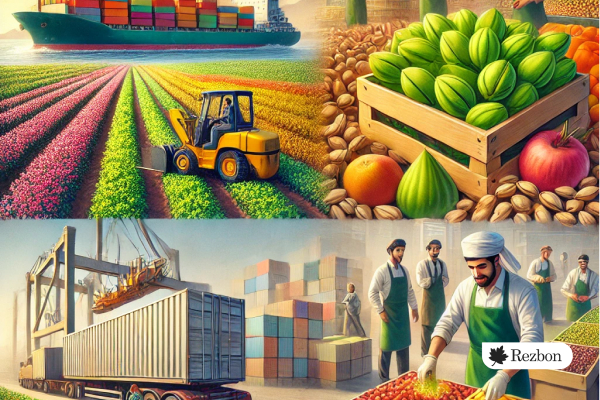Iran is one of the most significant agricultural producers in the Middle East, boasting a wide range of high-quality products such as pistachios, saffron, fruits, and vegetables. The export of these goods plays a crucial role in the country’s economy. In this article, we will explore the process of exporting agricultural products from Iran, from the moment they are harvested on the farm to their delivery to international markets.
1. Farming and Harvesting
The journey of agricultural products begins on the farm. Iranian farmers cultivate various crops based on the season and the specific demands of international markets. The primary agricultural regions include provinces like Kerman (pistachios), Khorasan (saffron), and Mazandaran (citrus fruits and rice).
Key considerations during farming:
- Sustainability and quality control: Farmers must adhere to agricultural best practices, ensuring the health of their crops. The use of organic methods and minimizing the use of pesticides are becoming more common as global demand for organic products rises.
- Irrigation and water management: Given the semi-arid climate of Iran, effective irrigation and water conservation techniques are vital for ensuring the quality and sustainability of agricultural produce.
- Harvest timing: Proper timing for harvesting is essential. Fruits, vegetables, and other perishables are harvested at the peak of their ripeness to ensure they retain their quality and freshness for export.
2. Post-Harvest Handling and Processing
Once the crops are harvested, they must undergo various post-harvest handling and processing steps to prepare them for export.
Steps in post-harvest handling:
- Sorting and Grading: Agricultural products are sorted by size, quality, and condition. Only the highest-quality products that meet international standards are selected for export.
- Cleaning and Packaging: The products are cleaned to remove any dirt or impurities. After cleaning, they are packed using appropriate materials that maintain their freshness during transportation. For example, perishable items like fruits are often packed in ventilated containers.
- Cold Storage (for perishable goods): Products such as fruits, vegetables, and dairy items require cold storage facilities to prevent spoilage before and during transportation.
3. Obtaining Certifications and Compliance
To export agricultural products from Iran, compliance with international regulations and standards is a key step.
Important certifications and regulations include:
- Phytosanitary Certificate: This certificate ensures that the exported agricultural products are free from pests and diseases. The Ministry of Agriculture in Iran issues this document after a thorough inspection of the crops.
- GlobalGAP Certification: Many international buyers require GlobalGAP certification, which verifies that the crops have been grown and harvested in compliance with good agricultural practices, focusing on food safety, environmental sustainability, and worker welfare.
- Organic Certification: For markets that demand organic produce, exporters need to obtain organic certification from recognized bodies, which ensures that no synthetic fertilizers, pesticides, or genetically modified organisms (GMOs) were used in production.
4. Logistics and Transportation
After processing and certification, the next crucial step is transportation. Proper logistics ensure that the products reach international markets in optimal condition.
Key logistics considerations:
- Mode of Transportation: The choice between air, sea, or land transportation depends on the destination and the nature of the products. Perishable goods like fruits or vegetables may be transported by air for faster delivery, while non-perishables like saffron or dried fruits are typically shipped via sea.
- Customs Clearance: Exporters need to work with customs authorities in both Iran and the importing country to ensure smooth clearance. In Iran, exporters must submit all necessary documentation, including invoices, certificates, and permits, to the customs office.
- Insurance: It is essential to insure agricultural shipments to protect against loss or damage during transit. Insurance policies typically cover risks such as theft, accidents, or spoilage during transportation.
5. Marketing and Distribution in the Destination Country
Once the products arrive at their destination, they go through final stages before reaching consumers.
Steps involved in the destination market:
- Customs Inspection: Upon arrival, agricultural products undergo customs inspection and clearance in the importing country. This is to ensure they meet the country’s food safety standards and import regulations.
- Distribution to Retailers or Buyers: After customs clearance, the products are distributed to wholesalers, retailers, or directly to consumers, depending on the business model. For high-demand goods like Iranian saffron or pistachios, direct contracts with large international buyers or supermarket chains may already be in place.
6. Challenges in Exporting Agricultural Products
While Iran’s agricultural exports hold great potential, there are several challenges exporters face:
- Sanctions and Economic Restrictions: International sanctions on Iran have complicated financial transactions and limited access to certain markets. Exporters often need to navigate complex banking channels to receive payments.
- Market Competition: Iranian exporters face competition from other countries that produce similar agricultural products. For instance, Turkish and U.S. pistachios compete directly with Iranian pistachios in global markets.
- Logistics and Infrastructure: While Iran has made progress in developing its infrastructure, challenges in transportation logistics and storage facilities can impact the efficiency of the export process.
7. Opportunities for Growth
Despite these challenges, there are significant opportunities for growth in the export of Iranian agricultural products.
- Demand for Organic and Specialty Products: Global demand for organic, non-GMO, and sustainably grown agricultural products is rising. Iranian exporters can capitalize on this trend by expanding organic farming and obtaining certifications.
- E-commerce and Direct-to-Consumer Sales: The rise of e-commerce platforms provides new avenues for Iranian agricultural exporters to reach international consumers directly, bypassing traditional distribution channels.
- New Trade Agreements: Iran is exploring trade agreements with countries in Asia, Africa, and Latin America, which may open up new markets for its agricultural exports.
Conclusion
The process of exporting agricultural products from Iran is a complex, multi-stage operation that requires attention to quality, compliance with international standards, and efficient logistics. Despite the challenges, Iran’s rich agricultural sector holds great potential for global markets, and with proper investment and strategic planning, the country’s exports can continue to grow and flourish.


